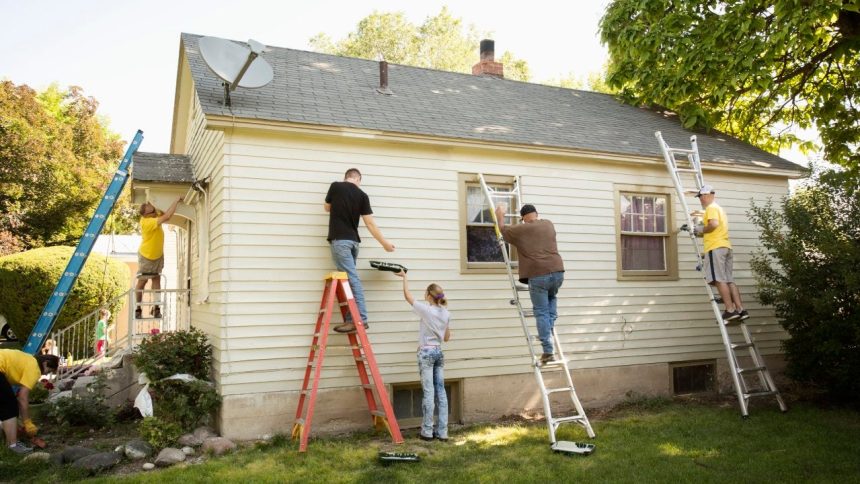Hill Street Studios/Getty Images
Key takeaways
- Flipping houses involves buying a property for a low price and selling it quickly for a profit.
- Successful flipping requires significant capital, careful budgeting and a team of trustworthy contractors.
- While there is potential for big profits, there are also big risks and potential losses.
Tune in to HGTV on any given day, and you’ll come across programs where smiling people transform eyesore properties into jaw-droppingly beautiful homes. Sometimes these magicians are professional real estate investors, sometimes they’re just ordinary individuals — but they almost always resell the newly renovated property for a tidy profit.
Welcome to the lucrative world of flipping houses. According to real estate data firm ATTOM, nearly 68,000 U.S. homes were flipped in the first quarter of 2024 alone — that’s one out of every 12 homes sold. What’s more, ATTOM data shows that the flippers typically earned a gross profit of more than 30 percent on each transaction.
Of course, house flipping in real life is almost never as easy as it looks on TV. If you’re interested in giving it a try, here’s a guide to flipping houses for beginners.
What is house flipping?
House flipping is when someone buys a property, holds on to it for a short time and then sells it for a higher price. The quick-turnaround resale is why it’s called a “flip.” So instead of buying a home to live in as a residence, you’re buying it as an investment — in effect, speculating in it as you would a stock.
Sometimes, flipping houses means you buy a fixer-upper and renovate it to make it market-ready; other times, it means just holding the property until the market shifts and you can sell it for more than you paid for it. Either way, the goal is to buy low and sell high, earning a profit in a relatively short amount of time (usually within a few months to a year).
House flippers need a lot of money on hand for the upfront costs of purchasing, carrying and renovating the home, and they have to budget very carefully to make sure they don’t spend more than they’ll be able to earn back in resale. They also need a team of trusted contractors and service providers at the ready to get any needed work done as quickly as possible.
Pros and cons of flipping houses
There are many rewards associated with house flipping, but there are serious risks, too.
Pros
- Potential for big profits: The typical gross profit (the difference between the median purchase price paid by investors and the median resale price) for house flips was $72,375 in the first quarter of 2024, according to ATTOM. That’s a very nice amount for a short-term job, to be sure, but keep in mind the high levels of spending required to get there.
- Improving neighborhoods: Flipping houses can help turn around property values in areas where neglected or derelict homes are dragging down prices. “Most of the houses I buy are in a distressed condition or coming from a distressed seller,” says Matt Aitchison, a real estate investor and host of the podcast The 6 Figure Flipper. “The ability to truly solve someone’s problem while making a significant profit that can be used to build wealth is an amazing thing that I love about flipping.”
- Diversify your investments: Investing in different types of assets is often considered a good way to reduce risk. As an alternative to stocks and bonds, real estate is one of the most popular long-term investments: Adding real estate to your investment portfolio can help diversify your holdings, and flipping properties lets you cash in those investments.
Cons
- Potential for big financial losses: There’s no reward without risk. House flipping comes with a lot of pressure to buy wisely and move quickly. If your property sits on the market, you’re responsible for paying all of its costs, including the mortgage payment (if you’ve financed it), property taxes, homeowners insurance and homeowners association dues. “It can be financially draining,” Aitchison says. For this reason, it’s important that you have some capital set aside in case your flip is a flop.
- Likelihood of significant problems: Finding a home that can be bought cheaply enough to flip for a profit can be tricky. Flippers could be looking at much higher-than-anticipated costs if unexpected issues arise. “What if you open things up and you find asbestos? Mold? Termites?” says Amanda Pi of Pi Home Solutions in Ridgewood, New Jersey. “There are tons of different things you could find when you do renovations.”
-
Possible legal issues: If you buy a home that turns out to have title issues, or the buyer finds issues you didn’t fix or address appropriately, there’s always the potential for lawsuits. Having a solid team looking out for your interests is important, says Aitchison: “[I’ve] seen a lot of lawsuits on both sides. Having a great real estate attorney is part of having the right team members in place.”
How to flip a house, step-by-step
- Set a budget: House flipping is expensive, and the first step is to make sure you have your finances in order. If you’re a first-time flipper, whatever amount you think is enough probably isn’t, says Pi. Don’t go in conservatively — she suggests multiplying your current budget by five. If you’ll be financing the purchase, make sure you’re preapproved for a mortgage before you start looking.
- Find a property: Next, look for properties that fit your finances. Browse through foreclosures, auctions and short sales to see what best matches up with your budget and renovation ability. A local real estate agent who has experience working with flippers can help you find properties that will give you the best return on your investment. (However, you may have to pay them a commission fee, which will eat into your profits.)
- Make an offer: When you find the right property, it’s time to make an offer. Professional flippers often consider a home’s after-repair value to help them determine how much to bid — and keep in mind that in popular markets, you may well be bidding against these pros. You might want to have multiple properties in mind in case you’re outbid on your first choice.
- Set a timeline: Once you’ve bought a home, the clock starts ticking. The amount of time you’ll need to get it resale-ready will depend on how extensive the required repairs and upgrades are. Whether it’s one month or six, give yourself enough time to get the work done, and factor in time for building inspections (if needed).
- Hire a contractor: Unless you’ve got the chops (and time) to handle repairs and renovations yourself, you’ll want to hire reputable tradespeople. Some contractors have full teams to work on all areas of the home, but not all. Check licenses and references before you commit to anyone, and also make sure their quotes are in line with your budget and they can meet your timeline.
-
Sell your property: After all updates have been made, it’s time to put your property up for sale. A real estate agent can help you price and market the home (though again, you’ll likely have to pay them a commission). If you make a profit, congratulations — you can put the money toward buying your next flip!
Common house-flipping mistakes
While there is financial opportunity in flipping houses, don’t get into it without significant capital, guidance and preparation. Here are some common mistakes to avoid.
- Not having enough money: Keep to what you can afford. Not every project is a TV-worthy transformation with a giant payday; some flips can be modest clean-and-repair jobs that help you gain experience and confidence. “Everything adds up quickly, and contractors [can] take advantage if you’re a novice,” says Pi.
- Thinking it’s easy: While you don’t need a license to flip homes, it’s not as simple and fun as TV shows portray it. “It takes time and money, and (you) shouldn’t go in blindfolded,” Pi says. “There are lots of amateurs. They get burned and lose a lot of money.”
- Not building the right team: It’s crucial to work with experienced, reputable people, Pi says. Your team might include a more experienced mentor, a real estate agent, a contractor, a home inspector, an attorney and even an accountant.
- Not giving it your full attention: Flipping houses is much more difficult when you also have a regular day job. “It’s not a good side-hustle,” Pi says. “If issues come up on-site, someone needs to be there. If you’re going to do it, do it full time.”
Bottom line
When it comes to flipping houses, it’s easy to be blinded by the potential for huge profits. But before jumping into a project, be sure you can afford a potential loss. Even if the renovations go perfectly according to plan, the real estate market can be volatile, and high interest rates mean there are fewer buyers out there who can afford a home purchase. Save your future self by keeping a solid emergency savings fund in case you lose money, and be sure you have a trustworthy team to work with before you buy.
Read the full article here
















